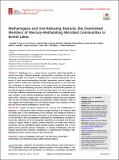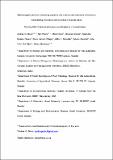Por favor, use este identificador para citar o enlazar a este item:
http://hdl.handle.net/10261/174667COMPARTIR / EXPORTAR:
 SHARE SHARE
 CORE
BASE CORE
BASE
|
|
| Visualizar otros formatos: MARC | Dublin Core | RDF | ORE | MODS | METS | DIDL | DATACITE | |

| Título: | Methanogens and Iron-Reducing Bacteria: the Overlooked Members of Mercury-Methylating Microbial Communities in Boreal Lakes |
Autor: | Bravo, Andrea G. CSIC ORCID ; Bertilsson, Stefan | Palabras clave: | Mercury Methylation hgcA gene Sulfate-reducing bacteria Iron-reducing bacteria 16S rRNA gene Boreal lakes Methanogens |
Fecha de publicación: | dic-2018 | Editor: | American Society for Microbiology | Citación: | Applied and Environmental Microbiology 84(23): e01774-18 (2018) | Resumen: | Methylmercury is a potent human neurotoxin which biomagnifies in aquatic food webs. Although anaerobic microorganisms containing the hgcA gene potentially mediate the formation of methylmercury in natural environments, the diversity of these mercury-methylating microbial communities remains largely unexplored. Previous studies have implicated sulfate-reducing bacteria as the main mercury methylators in aquatic ecosystems. In the present study, we characterized the diversity of mercury-methylating microbial communities of boreal lake sediments using high-throughput sequencing of 16S rRNA and hgcA genes. Our results show that in the lake sediments, Methanomicrobiales and Geobacteraceae also represent abundant members of the mercury-methylating communities. In fact, incubation experiments with a mercury isotopic tracer and molybdate revealed that only between 38% and 45% of mercury methylation was attributed to sulfate reduction. These results suggest that methanogens and iron-reducing bacteria may contribute to more than half of the mercury methylation in boreal lakes.IMPORTANCE Despite the global awareness that mercury, and methylmercury in particular, is a neurotoxin to which millions of people continue to be exposed, there are sizable gaps in the understanding of the processes and organisms involved in methylmercury formation in aquatic ecosystems. In the present study, we shed light on the diversity of the microorganisms responsible for methylmercury formation in boreal lake sediments. All the microorganisms identified are associated with the processing of organic matter in aquatic systems. Moreover, our results show that the well-known mercury-methylating sulfate-reducing bacteria constituted only a minor portion of the potential mercury methylators. In contrast, methanogens and iron-reducing bacteria were important contributors to methylmercury formation, highlighting their role in mercury cycling in the environment. | Descripción: | Bravo, Andrea G. ... et al.-- 16 pages, 7 figures, 3 tables, supplementary material https://aem.asm.org/content/84/23/e01774-18/figures-only | Versión del editor: | https://dx.doi.org/10.1128/AEM.01774-18 | URI: | http://hdl.handle.net/10261/174667 | DOI: | 10.1128/AEM.01774-18 | Identificadores: | doi: 10.1128/AEM.01774-18 issn: 0099-2240 e-issn: 1098-5336 |
| Aparece en las colecciones: | (ICM) Artículos |
Ficheros en este ítem:
| Fichero | Descripción | Tamaño | Formato | |
|---|---|---|---|---|
| Bravo_et_al_2018.pdf | 676,77 kB | Adobe PDF |  Visualizar/Abrir | |
| Bravo_et_al_2018_s1.pdf | 887,29 kB | Adobe PDF |  Visualizar/Abrir |
CORE Recommender
PubMed Central
Citations
11
checked on 24-abr-2024
SCOPUSTM
Citations
44
checked on 17-abr-2024
WEB OF SCIENCETM
Citations
43
checked on 26-feb-2024
Page view(s)
238
checked on 24-abr-2024
Download(s)
269
checked on 24-abr-2024

